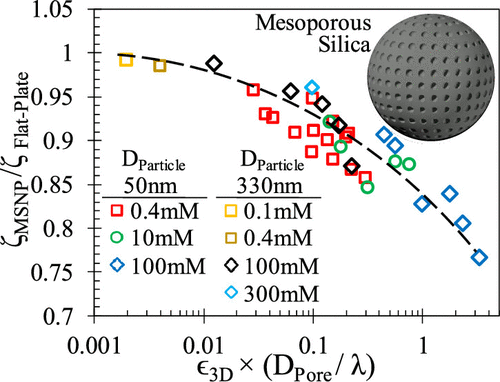当前位置:
X-MOL 学术
›
J. Phys. Chem. C
›
论文详情
Our official English website, www.x-mol.net, welcomes your
feedback! (Note: you will need to create a separate account there.)
Pore Size and Porosity Dependent Zeta Potentials of Mesoporous Silica Nanoparticles
The Journal of Physical Chemistry C ( IF 3.3 ) Pub Date : 2020-08-10 , DOI: 10.1021/acs.jpcc.0c04602 Fetiye Esin Yakin 1 , Murat Barisik 2 , Tumcan Sen 2
The Journal of Physical Chemistry C ( IF 3.3 ) Pub Date : 2020-08-10 , DOI: 10.1021/acs.jpcc.0c04602 Fetiye Esin Yakin 1 , Murat Barisik 2 , Tumcan Sen 2
Affiliation

|
Mesoporous silica nanoparticles (MSNPs) are synthesized in the various forms of porous structures according to an application’s needs, while their zeta potentials play a major role in their function. We show that variation in pore size and/or porosity yields a substantial decrease in MSNP zeta potential up to 25% lower than the theoretical zeta potential predictions for a flat surface at the corresponding ionic conditions in moderate pH range. By considering surface chemistry as a function of local ionic conditions (charge regulation), we calculated local zeta potentials around the MSNP which showed variation between pore openings and solid surfaces. Through a systematic study, we evaluated an average three-dimensional zeta potential for MSNPs with various conditions, based on the ratio of the area covered by pore openings to the rest of the MSNP surface area as a function of three-dimensional porosity and pore size. Results show that the high overlap of ionic layers inside the pores creates electric potentials close to zeta potential of the remaining surface, but large pore size and/or high ionic salt concentration yields divergence. We characterized the variation of MSNP zeta potential in terms of porosity (ε3D), pore size (Dpore), and ionic condition quantified by Debye length (λ) and obtained unified behavior as a function of the nondimensional group of ε3D(Dpore/λ). For ε3D(Dpore/λ) < 0.01, MSNP zeta potential remains similar to flat plate predictions, but it decreases by increasing ε3D(Dpore/λ) value. The influence of pore entrances on surface zeta potential increases nonlinearly by the increase of porosity and/or decrease of EDL overlap, similar to a change of area to volume ratio. The current findings are important for the understanding and further control of mesoporous particle transport in various promising and groundbreaking applications such as targeted drug delivery.
中文翻译:

介孔二氧化硅纳米颗粒的孔径和孔隙率依赖性ζ电势
介孔二氧化硅纳米颗粒(MSNP)可根据应用需求以各种形式的多孔结构合成,而它们的Zeta电位在其功能中起主要作用。我们显示,孔径和/或孔隙率的变化会导致MSNP Zeta电位大幅降低,比在中等pH范围内相应离子条件下平坦表面的理论Zeta电位预测值低25%。通过考虑作为局部离子条件(电荷调节)的函数的表面化学,我们计算了MSNP周围的局部Zeta电位,该电位显示出孔口和固体表面之间的变化。通过系统的研究,我们评估了各种条件下MSNP的平均三维ζ电势,取决于孔隙的覆盖面积与其余MSNP表面积的比值(三维孔隙率和孔径的函数)。结果表明,孔内离子层的高度重叠产生的电势接近其余表面的ζ电势,但是大孔径和/或高离子盐浓度会产生发散。我们用孔隙度来表征MSNP zeta电位的变化(ε 3D),孔径(d孔隙),以及由德拜长度(λ)来定量离子状态并获得统一行为的无因次群的函数ε 3D(d孔/ λ)。对于ε 3D(d孔/ λ)<0.01,MSNPζ电位遗体类似于平板的预测,但它通过增加而减小ε 3D(d孔隙/ λ)值。孔隙率的增加和/或EDL重叠的减少,使孔隙入口对表面zeta电位的影响非线性增加,类似于面积与体积比的变化。当前的发现对于理解和进一步控制各种有前途和突破性应用(例如靶向药物递送)中的中孔颗粒传输非常重要。
更新日期:2020-09-10
中文翻译:

介孔二氧化硅纳米颗粒的孔径和孔隙率依赖性ζ电势
介孔二氧化硅纳米颗粒(MSNP)可根据应用需求以各种形式的多孔结构合成,而它们的Zeta电位在其功能中起主要作用。我们显示,孔径和/或孔隙率的变化会导致MSNP Zeta电位大幅降低,比在中等pH范围内相应离子条件下平坦表面的理论Zeta电位预测值低25%。通过考虑作为局部离子条件(电荷调节)的函数的表面化学,我们计算了MSNP周围的局部Zeta电位,该电位显示出孔口和固体表面之间的变化。通过系统的研究,我们评估了各种条件下MSNP的平均三维ζ电势,取决于孔隙的覆盖面积与其余MSNP表面积的比值(三维孔隙率和孔径的函数)。结果表明,孔内离子层的高度重叠产生的电势接近其余表面的ζ电势,但是大孔径和/或高离子盐浓度会产生发散。我们用孔隙度来表征MSNP zeta电位的变化(ε 3D),孔径(d孔隙),以及由德拜长度(λ)来定量离子状态并获得统一行为的无因次群的函数ε 3D(d孔/ λ)。对于ε 3D(d孔/ λ)<0.01,MSNPζ电位遗体类似于平板的预测,但它通过增加而减小ε 3D(d孔隙/ λ)值。孔隙率的增加和/或EDL重叠的减少,使孔隙入口对表面zeta电位的影响非线性增加,类似于面积与体积比的变化。当前的发现对于理解和进一步控制各种有前途和突破性应用(例如靶向药物递送)中的中孔颗粒传输非常重要。




















































 京公网安备 11010802027423号
京公网安备 11010802027423号